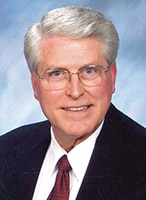 Gabriel and Mary
Gabriel and Mary
Formations: December 1, 2019
Scripture: Luke 1:26-38
What an opening scene for the life of a very young Jewish girl in a small Galilean village, the mother of God’s Son! “Greetings, favored one! The Lord is with you” (v. 28). Mary has been described as the mother of God, a co-redemptress, sinless, and the womb of God’s grace. None of those exalted titles captures the humility, tensions, fears, and incredible spiritual strength of this woman.

Michael K Olmsted
Like her husband Joseph, her ancestry stretched back in the family of Kind David. Gabriel’s startling announcement probably occurred when she was only a teenager, bound to Joseph by a formal marriage contract, but before they had observed the usual rituals of marriage. “How can this be, since I am a virgin?” was her honest, if fearful, response.
You know the rest of this story. The final month of her pregnancy, she and Joseph made the very difficult journey to their family’s original home, Bethlehem, because of a government ruling about a census (Luke 2:1-7). Jesus was born, probably in the attached barn of a home, because the town was overwhelmed with travelers just like Joseph and Mary. Curious how God can use the most challenging circumstances to present his grace to a world that loves its own ideas, while the answer to our deepest need appears so simply.
Mary not only welcomed this child who is God’s ultimate gift, she marveled at exotic wise men from the east, shepherds who witnessed a host of heaven’s angels, and God’s warning to flee to Egypt because of King Herod’s plot to kill her baby (Lk. 2:8-20; Matthew 2:1-18). This same Mary observed and worried about her son; her love and understanding of God empowered that son to confront the hypocrisy and crushing legalism that pushed God’s grace and forgiveness aside. She witnessed the insults and very real threats that finally led to Jesus’ cruel death on a cross. If we wonder about the love between mother and son, we witness the depth of that relationship, when Jesus was dying on the cross he said to Mary, “Woman, behold your son!” Then he spoke to the “beloved apostle John,”: “Behold, your mother!” And John took Mary to his own home that day (John 19:26-27).
The span of the Jesus story is shaped on love and relationships. God is at the center, and for all the healing and miracles, the challenges to rigid legalism, the collusion of church (synagogue) and state, the focus on theology and ritual, we are constantly confronted by the God of love and grace. Why then should it seem so strange to us that Mary of Nazareth should find herself face-to-face with the angel Gabriel? How can this message be plausible? Mary says it plainly: “I am a virgin” (v. 34).

Pixabay
No time-worn philosophical statement here: “The Holy Spirit will come upon you, and the power of the Most High will overshadow you; therefore the child to be born will be holy; he will be called Son of God” (v. 35). This is remarkably different from any pagan ideas about self-serving gods, temple prostitutes, government-mandated religion, or claims of national destiny. God patiently and deliberately chose the person, time, and place to bring his grace to us in the form of a fragile, vulnerable infant who would reveal God in the most startling way
There is yet another curious twist to this Christmas story. Gabriel also announces: “And now, your relative Elizabeth in her old age has also conceived a son; and this is the sixth month for her who was said to be barren. For nothing will be impossible with God” (vv. 36-37). The Gospel of Luke consistently highlights the unusual ways God acts to reveal his grace. I have often marveled at how God speaks to us and draws us to his gift of life through the people and experiences of everyday life
Mary realized she was not alone in her astonishment at the news that her much older relative Elizabeth was expecting a baby. This whole story was not described by the prophets of old. The miracle of God’s love and grace was becoming reality because that is the world in which we live. Both of these women were shocked, but both loved God above all else. They were not qualified as scholars of the law, members of the Jerusalem elite, or more spiritually insightful than others … they were simply willing to hear the voice of God and follow God’s leading.
Here is the lesson for us all. By the grace of God, through the leading of the Holy Spirit and the death and resurrection of Jesus Christ you are invited to share the good news of God’s transforming grace with the world around you.
The world’s holiday gift buying began before Halloween this year. So, what are your plans to share the gift of Christ with this confused and selfish world? Are you listening for the voice of God? What does Christmas really mean to you? There is nothing wrong with a Christmas tree, gift giving, or parties, but think about how you can share the gift of Christ. Spend some time meditating on this original Christmas story. Pay attention to those around you, at home, at school, on the job, on festive occasions, and listen for the Spirit’s urging to speak and act in a way that will show the Advent gift of God’s love.
Like Mary we must learn to say, “Here am I, the servant of the Lord; let it be with me according to your word” (v. 58). This may be the Christmas you discover a deeper faith and an openness to sharing Christ, by your lifestyle as well as your words. Mary lived beyond social expectations, beyond religious stereotypes, and became a significant servant of the Eternal God. What will be your role this Advent?
Formations is a curriculum series from Smyth & Helwys Publishing, Inc. through NextSunday Resources.
The PDF download requires the free Acrobat Reader program. It can be downloaded and installed at https://get.adobe.com/reader (uncheck optional offers first).


